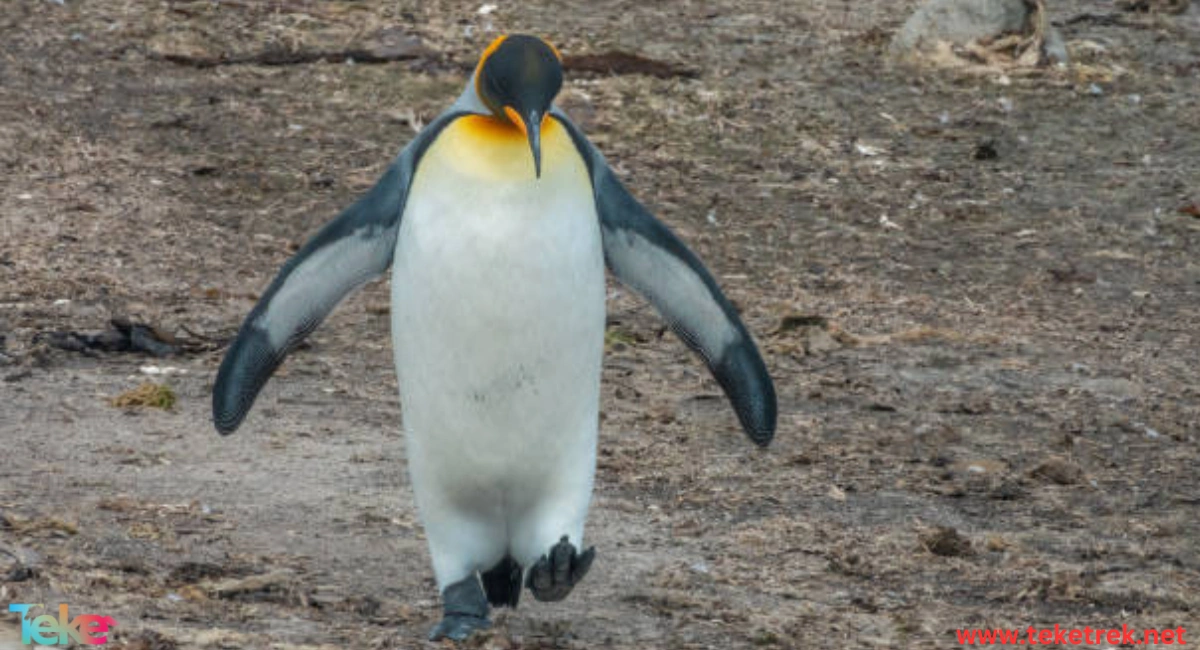The King Penguin, also known as the Royal Penguin, is one of the most fascinating bird species in the world. It belongs to the order and family of penguins and primarily inhabits Macquarie Island, a peninsula close to the Antarctic. Additionally, it can be found on some nearby islands. In this article from teketrek, we will explore essential information about the King Penguin, including its habitat, diet, and other intriguing facts.
Scientific Classification of the King Penguin
The King Penguin belongs to the penguin family, and its detailed scientific classification is as follows:
- Kingdom: Animalia
- Phylum: Chordata
- Class: Aves
- Order: Sphenisciformes
- Family: Spheniscidae
- Species: Aptenodytes patagonicus

Physical Characteristics of the King Penguin
The King Penguin is the second-largest penguin species in the world, with an average height ranging from 65 to 76 cm (26 to 30 inches) and a weight of approximately 6.6 to 17.6 lbs (3 to 8 kg). The name “King Penguin” originally stemmed from its size, as it was once believed to be the largest penguin species until the discovery of the Emperor Penguin in 1884, which surpassed it in size.
The King Penguin is distinguished by its white face and chin, along with orange-yellow feathers on its upper chest and colorful patches on the sides of its head. Its large, orange beak is one of its most striking features. Juvenile King Penguins differ in appearance, having dark brown plumage, which initially led scientists to mistakenly classify them as a separate species, calling them the “woolly penguin.”
https://teketrek.net/en/the-sand-dollar-facts-about-the-fascinating-marine-animal/
Habitat of the King Penguin
King Penguins live in colonies in the waters surrounding Antarctica. During the breeding season, they migrate to the shores of Macquarie Island, located in the southwestern Pacific Ocean. They inhabit areas among rocks and small shrubs, breeding on slopes and grassy patches. Out of the approximately 1.1 million pairs of King Penguins, around 850,000 pairs are found on Macquarie Island.
Diet of the King Penguin
The King Penguin primarily feeds on krill but also consumes small fish, eel fish, squid, crustaceans, and cephalopods. Remarkably, the King Penguin is an extraordinary hunter, capable of catching up to 2,000 fish in a single day!
Additionally, it is an excellent swimmer, using its large flippers to swim at speeds of up to six miles per hour. The King Penguin dives to great depths in search of prey, sometimes reaching over 1,180 feet. At these depths, light is scarce, but this does not hinder the King Penguin, as it has excellent night vision, enabling it to hunt effectively in the dark.
The King Penguin faces natural predators such as seals, sea lions, and orcas. On rocky shores, its eggs and chicks are threatened by turkey vultures and giant petrels like the caracara.
Reproduction of the King Penguin
The breeding season for King Penguins begins at the end of winter, when they migrate to Macquarie Island and nearby islands. It multiplies in the period between September to February. The males arrive first and dig a nest in the sand or on slopes. When the females arrive in October, mating occurs. Typically, the female lays one or two eggs at intervals and then incubates them until they hatch.
Interestingly, both males and females take turns incubating the eggs on their feet to keep them warm with a special layer of bare skin called the brood pouch. The eggs usually take 30 to 40 days to hatch, and once they do, the chicks emerge. The parents must care for the chicks, protecting them from predators and feeding them by regurgitating food into their mouths.
In the first three weeks, the chicks depend on their parents for food. After that, they begin to join their parents on foraging trips, initially moving in groups for safety. For the first 70 days, the chicks regularly return to their nests. After this period, they leave the nest and live independently. By the age of one year, the King Penguin reaches sexual maturity and is ready to breed. The average lifespan of a King Penguin is 15 to 20 years.
https://teketrek.net/en/wildlife-in-winter-the-struggle-for-survival-amid-the-ice/
Adaptations of the King Penguin
Like other penguin species, the King Penguin is well-adapted to freezing climates. Its dense feathers form a thick, protective layer that helps it retain body heat, and a layer of fat beneath its skin also aids in maintaining warmth. Interestingly, the King Penguin’s feet are not covered in feathers, and the blood in its feet is cold. This is because the penguin’s heating system is so efficient that it needs an outlet to release excess heat.
The heat dissipates through the feet and beak, thanks to a unique arrangement of blood vessels where warm blood vessels encircle cold ones, transferring heat to the cold blood in the feet. The King Penguin’s wings are adapted into flippers that aid in swimming, and its feathers provide camouflage from predators. It also has excellent vision, allowing it to swim in deep waters in search of prey.
Periodically, King Penguins come ashore for a complete molting process, where they shed all their feathers and replace them with new, water-resistant ones. This process takes about three weeks.

Frequently Asked Questions
Is the King Penguin endangered?
Some believe that King Penguins are not currently endangered, with large populations totaling approximately 1.1 million breeding pairs each year.
Where does the King Penguin live?
The King Penguin spends most of its life at sea, returning to land only to lay eggs and breed. This process requires a dry location, typically found at the polar front, 350 kilometres south of the Crozet Archipelago.
In conclusion, we have explored one of the most famous penguin species in the world, the King Penguin, known for its distinctive appearance and adaptations. Although there are concerns about its survival due to climate change, scientists reassure that there is no immediate cause for alarm as long as large numbers continue to breed annually.





